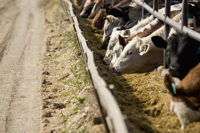To the Point
By Lynn Petrak, Special Projects Editor
Injection technology evolves based on processors’ desire for versatility, safety, and reliability.
Getting needled to come up with innovative machinery isn’t so bad, at least for those involved in injection technology. Equipment used to tenderize and marinate cooked and raw meat and poultry runs on the same basic principles as it has for years, but there have been notable advances in the design and application of injection systems.
Flexibility has been a powerful driver of refinements in injection technology in recent years, as processors expand their product lines and continue to improve throughput. MEPSCO, a West Chicago, IL division of Cooling and Applied Technology Inc., Russellville, AR, recently introduced a new series of ULTRA injection machines, which were designed with versatility in mind. One of the latest versions is the company’s double-head injector that can be used to run two injectors at once or an injector and a tenderizer.
“There is a lot more adjustability, where you can go on the control panel and change the needle pattern,” explains division president Bob Benton.
Versatility has also proved important for customers of Canton, MA-based REISER. The company’s FOMACO FGM 88SC injector features an easy-to-change needle system that allows operators to use 3-mm, 4-mm, or 5-mm needles on the same machine with changeover times of minutes versus hours, and includes a filter system that requires no operator involvement. The system, which will soon be expanded to include a new FOMACO Mark 3 with a redesigned, easy-to-reach cabinet, also allows for a broader use of solutions, relays processing specialist Rich Hardin.
“The injector can be equipped with brine rechill for temperature-sensitive products or special filter arrangements to eliminate settling of high-starch or protein brines. The injector can also be used for highly viscous injection solutions,” Hardin explains. As with other types advanced injectors, the FOMACO FGM 888SC and the FOMACO Mark 3 come with a touchscreen and PLC-operating system.
Customization is key as well for Wolf-tec Inc., Kingston, NY, which offers an injection system that best suits protein types being produced at the time.
“Most processors today have an increased range of products being injected, which mandates a system that offers the flexibility to meet their needs, whether high pump or low pump, low profile or tall products, beef, ham, or chicken,” points out Peter Ludwig, company president. “It still remains a process that requires the proper combination of needle diameters and exit-hole sizes, injection pressures, and needle penetrations per square inch.” Among other features, Wolf-tec’s control systems run precise programs, which set up the system for each product.
Another manufacturer, Koch Equipment LLC, supplies injectors equipped for multi-tasking. “A good example of new technology is the single-injector machine that is designed to handle multiple product lines to allow the processor to produce different products with varying injections,” says Doug Rock, senior meat processing advisor, noting that the machine is particularly beneficial for poultry. “Chicken breasts, legs, and wings may be processed efficiently with identical or differing injection quantities in separate product runs. Needle cartridges can be changed over within a few seconds for each product variation.”
Integration is another hallmark of today’s versatile injectors. Townsend Engineering Company, Des Moines, IA, spent several years refining technology for its new 8000 series of bacon injectors. “All of the things we learned over the years from users we’ve incorporated into the new models — the operator interface, the built-in scales, and the bilingual touchscreens,” says Jack Kish, product development.
Flexibility may be a growing demand among meat and poultry companies, but injector accuracy remains a key issue. “The most popular concern right now is accuracy — accuracy is more important than speed because that is what costs the most money,” points out John Sbraga, owner of Nu-Meat Technology Inc., South Plainfield, NJ. “With the variables in fat content, bone content, and skin, it’s about trying to get needles in an accurate position in meat versus a pattern that winds up landing in bone or fat.”
Tied in with accuracy is the ability to ensure consistent performance. “A modern injector must have ability to monitor, track, and record vital set points and make sure that the operators cannot run out of spec as they so often have done in the past, thus plaguing products with deficiencies and consistency problems,” says Ludwig. To that end, Wolf-tec and Schröder have developed a control platform which enables a processor to keep the system in check and to hold operators more accountable for the injection process, Ludwig says.
Koch Equipment also emphasizes the importance of validation.
“The ability to monitor and or control injection via USB/Ethernet and standard CAN bus hardware allows the processor to set high/low limits and hard copy track the injection process to ensure proper yields, operation, and documentation,” Rock says.
Beyond function, modern injection systems have been designed for food-safety purposes as well. MEPSCO’s ULTRA injectors, for example, include several hygienic features. “We started with the new sanitary design principles, which means that we’ve gone to a high-polish finish and no flat surfaces on the top, so everything drains away from the product,” Benton explains.
Ludwig agrees that demand for sanitation and clean-in-place (CIP) features has escalated in recent years. “Processors have an increased focus on equipment hygiene and a hygienic-designed injector inside and out — the concern for potential contamination and microbial issues inside the actual brine path has reached staggering heights” he explains.
Wolf-tec and European sister company Schröder exclusively offer a completely external brine path for easier inspection of the entire system. “Even the pump and motor are mounted conveniently outside the machine on the brine tank assembly.”
Meanwhile, REISER’s new FOMACO Mark 3 cabinet has been redesigned to allow for easier access for cleaning. “Simplicity of cleaning has always been one of FOMACO's fine points and has been enhanced on this new design,” says Hardin
Although some injectors have a life span of 10 to 15 years, many meat and poultry companies are looking at new systems.
Rock, too, says that meatpackers are taking advantage of the latest injection technology. “Not only for competitive reasons and increased profits, but newer technology allows the processor to more safely manufacture products in an environment that is bacteriological sound as long as shelf life is properly maintained,” he says. “This is especially important in fresh, pre-marinated lines to maintain integrity to the end user.” NP
Technology providers participating in this article include:
Koch Equipment LLC phone (800) 777-5624
MEPSCO Inc., phone (630) 231-4130 or (800) 323-8535
Nu-Meat Technology Inc., phone (908) 754-3400
REISER, phone (781) 821-1290
Townsend Engineering Company, phone (515) 265-8181 or (800) 247-8609
Wolf-tec Inc., phone (845) 340-9727 or (800) 257-4627

